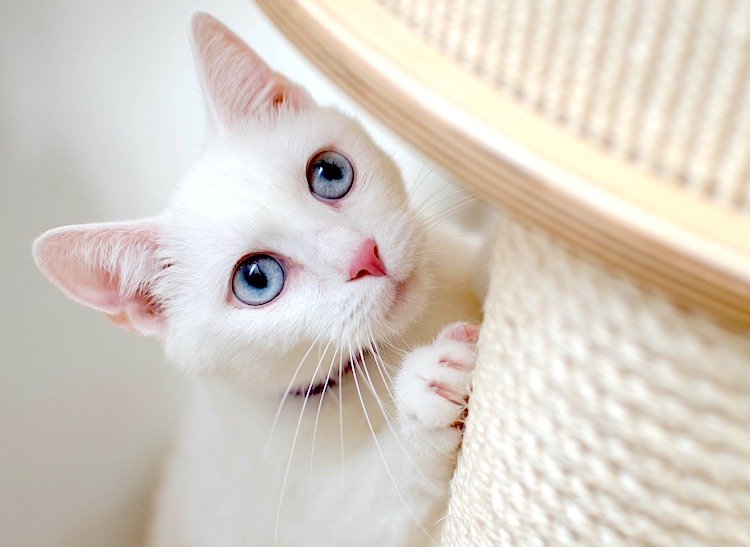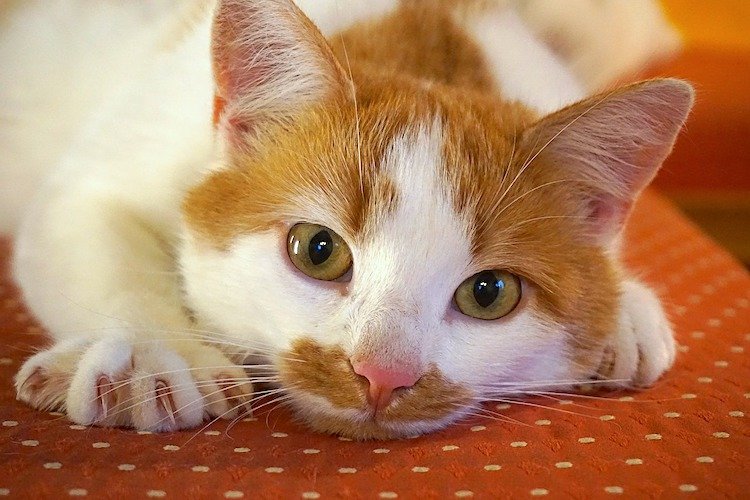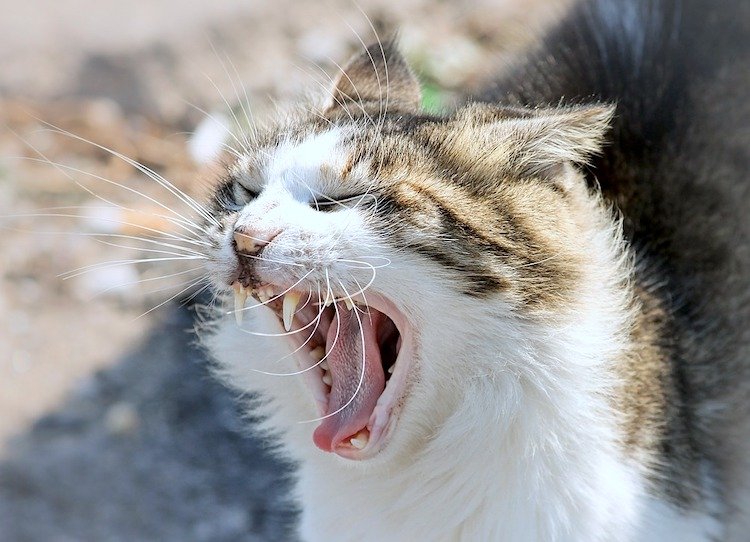
Is your cat ignoring you more than usual or acting oddly?
From extra-loud meowing to no longer fearing the vacuum, the impact of deafness varies among cats.
This article aims to answer all of your questions about hearing loss in cats, including what are the symptoms of deafness in cats and the effect of hearing loss on our feline friends.
How Can You Tell If a Cat Is Losing Their Hearing?
It sounds obvious, but to work out if a cat is losing their hearing, watch the cat’s reaction to everyday noise.
You, the caretaker, are often better placed than the veterinarian to know if the cat has gone deaf. Vet clinics are stressful places for cats, and with so much adrenaline and cortisol whizzing round their bloodstream, they often freeze in fear and don’t react normally.
How to Test Your Cat’s Hearing at Home
- Choose a time when the cat is awake and relaxed.
- Assemble a variety of objects that make noises of different pitches, ranging from high to low. For example, you might choose a whistle, pan lids and a wooden spoon inside a cardboard box.
- Go behind the cat so that they don’t see what you’re doing. Choose one of the items and make a noise, gently at first.
- Watch what happens. Does the cat look round or become alert?
- If they remain blissfully unaware, then up the volume. If necessary, get louder and louder until the cat reacts.
- Now try again with a sound of a different pitch.

Why Try a Range of Pitches?
Cats, like dogs, have a highly developed sense of hearing — which coincidentally peaks at the frequency of mice chatter. In fact, a cat has more in common with a whale’s hearing than a human’s:
- Beluga whale hearing range: 1,200 Hz–120,000 Hz1
- Cat hearing range: 48 Hz–85,000 Hz2
- Dog hearing range: 67 Hz–45,000 Hz
- Human hearing range: 20 Hz–20,000 Hz3
These figures tell us cats hear high-frequency noise much better than people do.
These high-frequency sounds are also the first to be lost when a cat becomes deaf. Which means cats first fail to hear noises we were never able to hear in the first place.
By the time we humans become suspicious a cat isn’t hearing so well, the cat has already lost a significant amount of high-frequency hearing. So while they may be able to hear mid-frequency noises, such as footsteps, they won’t hear higher-frequency sounds, such as squeaky door hinges.
This is a minor difference for our pet pals, but for a feral cat surviving by hunting, this loss of higher-frequency sounds makes a big difference. When they can’t hear their prey — mice — it means less likelihood of catching dinner, and they may go hungry.
So remember, if you test only the cat’s ability to hear low-frequency sound, you might miss hearing loss where it matters most to the cat.
A Note About Whiskers
A cat’s senses are much more sophisticated than our dull wits. Their magnificent whiskers are super-sensitive at detecting vibration, including the air disturbed when you’re banging pan lids together.
So when testing your cat’s hearing, take great care not to disturb their whiskers. The cat may not hear the sound with their ears, but they may feel vibration with their whiskers.
To avoid this, try standing with your back to the cat to shield them from air movement.
Next, we’ll discuss some of the biggest symptoms of deafness in cats.

7 Symptoms of Deafness in Cats
I remember, when my kids were young, visiting a rescue shelter to choose 2 new pet guinea pigs.
This event sticks in my mind because there was a cat who was loud — and I mean really loud. Although she was in the next-door cattery building, her meows were clearly audible in the rabbit shed. This cat was deaf.
Was YOUR Pet Food Recalled?
Check Now: Blue Buffalo • Science Diet • Purina • Wellness • 4health • Canine Carry Outs • Friskies • Taste of the Wild • See 200+ more brands…

Here are some of the signs of deafness in cats:
- Meowing loudly. The cats can’t hear themselves, so they turn up the volume. They simply don’t know what a racket they’re making.
- Noisy at night. (My guess is a dark house seems silent and deserted, and creating noise is oddly reassuring for deaf cats.)
- Not responding to their name or to the sound of the refrigerator door opening (or the can opener).
- No longer reacting to noises that once distressed them, such as fireworks or the vacuum.
- A change in habits, such as not greeting you when you enter the house.
- Sleeping longer and more deeply than previously.
- Seeming needy or clingy.
So if you’re wondering “Is my cat deaf or ignoring me?” and your cat shows some of the above symptoms of deafness in cats, then please check their hearing.
Health Checks and Deafness in Cats
As a caring pet parent, you should be aware that some health problems can mimic signs of deafness in cats.
For example, a cat with overactive thyroid glands can be very vocal, as the equivalent of a double-strength espresso stimulates this behavior. Likewise, a cat who feels unwell may show signs such as sleeping a lot.
If your cat changes their behavior, a vet check is always advisable. And although the vet can’t diagnose deafness (for the reasons explained above), they can check for ear polyps or an ear infection that muffles hearing.
Do Cats Lose Their Hearing When They Get Old?
A cat’s ability to hear decreases with age, in the same way that ours does.
Hearing depends on an intricate interaction between air vibrations that stimulate the ear drum (tympanum) to move 3 tiny bones (malleus, incus and stapes), which in turn vibrate tiny hairs suspended in fluid within the inner ear.
With age, any of these elements can become inflamed, damaged or plain worn out, which affects hearing. The older the cat, the more wear and tear on the delicate mechanics of the ear.
But hearing loss in a cat doesn’t happen only as a result of getting older. Again, just like people, cats can lose their hearing if subjected to damaging volume levels, such as loud music.
Types of Hearing Loss in Cats
There are 2 general categories of hearing loss in cats:
1. Conduction Deafness
This type of deafness occurs when sound waves don’t hit the nerves for hearing. Think of this as a problem with the physical mechanics of hearing, the equivalent of having a part seize up on a car engine.
Conduction deafness can be caused by inflammation of the outer ear, presence of tumors or ruptured ear drums. Some medications also promote this problem.
2. Nerve Deafness
This type of deafness arises from a lack of transmission of nerve messages from the ear to the brain. Nerve deafness can be either congenital or acquired through toxic drugs to the cat’s eyes or a tumor-like growth (neoplasia).
Deafness in older cats is caused by a combination of nerve damage and the bones of the inner ear fusing together.
Hearing loss due to aging requires the BAER response test. This necessitates special equipment available only at a few universities or specialist centers.4

Are White Cats Deaf?
Some cats have genetic glitches that make them deaf. Of these, white cats have the highest risk of deafness.
According to International Cat Care:5
- The chance of deafness is as high as 80% in a white cat with 2 blue eyes.
- But the odds drop for a white cat with just 1 blue eye, for whom there’s a 30–40% chance of deafness.
- For a white cat with no blue eyes, the chance of deafness falls to as low as 10% (which is still much higher than for non-white cats).
“There is no effective treatment for congenital deafness,” according to the Merck Veterinary Manual, which notes that “many cats with partial or complete deafness adapt very well to their condition.”6
Feline Hyperthyroidism and Hearing Loss
I’ve noticed that many cats with hyperthyroidism also seem to be deaf. However, this isn’t a direct consequence of the hyperthyroidism, but more the cat’s age since both conditions are common in older age.
Also, the symptoms of hyperthyroidism include being vocal and restless, which is hard to ignore when the cat loses their inner volume control.
Deafness and Cat Behavior
Deaf cats can feel vulnerable to predators. This can make them anxious or nervous, which in turn may make them seem more aggressive.
This isn’t a case of the cat becoming nasty. It’s more that, when taken by surprise, the cat may lash out in self-defense.
Deaf cats may also sleep longer and more deeply without everyday noises to disturb them. Actually, their sleep can seem alarmingly deep at times.
Are Deaf Cats More Affectionate?
Deeply bonded cats become more affectionate, or even needy, to their people. It’s as if their trust makes them seek you out for reassurance.
Do Deaf Cats Purr?
Yes, deaf cats most definitely purr! A purr is all about vibration, which is a source of comfort — which is why cats will purr even when they are in pain or frightened.
Do Deaf Cats Meow Differently?
Yes. Deaf cats can be extremely loud and noisy.
Besides the cats’ loss of volume control, one theory is that they use a form of vibration and echolocation.
By yowling loudly, they literally bounce sound off the wall and then detect it with their whiskers: a form of “cat radar.” That’s useful for the cat, but not so great for their people.
Check out this video of an adorable deaf cat, who is “easy to sneak up on,” according to his human:

Life With a Deaf Cat
A deaf cat can lead a happy, fulfilling life.
Helping them adjust doesn’t take much — just think about things from the cat’s perspective and stimulate their other senses.
A deaf cat will value your attention and engage in play. Great toys for deaf cats include the fluttery wing-on-a-string (wand) toy, which they can track with their eyes, or catnip-scented balls to stimulate their nose.
And finally, a few words about safety:
- A hard-of-hearing cat is more vulnerable to accident or injury, and should definitely be an indoor pet.
- However, you can expand their indoor world with a catio or cat towers to climb on, by using puzzle feeders, and by dedicating daily time to play and grooming.
Deafness shouldn’t mean dull!
References
- “All About Beluga Whales: Senses.” SeaWorld Parks & Entertainment. https://seaworld.org/animals/all-about/beluga-whales/senses/.
- Heffner, Rickye S., PhD, and Henry E. Heffner, PhD. “Hearing Range of the Domestic Cat.” Hearing Research 19, no. 1 (1985): 85–88. https://pubmed.ncbi.nlm.nih.gov/4066516/.
- “Hearing Health: Plot Your Spot on the Human Hearing Spectrum.” National Hearing Care. June 12, 2019. https://nhc.com.au/blog/human-hearing-range.
- “BAER Test for Hearing Loss.” BluePearl Specialty Emergency Pet Hospital. https://bluepearlvet.com/medical-articles-for-pet-owners/baer-test-for-hearing-loss/.
- “Inherited Deafness in White Cats.” International Cat Care. Sept. 5, 2018. https://icatcare.org/advice/inherited-deafness-in-white-cats/.
- Strain, George M., PhD. “Deafness in Cats.” Merck Veterinary Manual. https://www.msdvetmanual.com/cat-owners/ear-disorders-of-cats/deafness-in-cats.
 This pet health content was written by a veterinarian, Dr. Pippa Elliott, BVMS, MRCVS. This article was originally published in 2012 and is regularly updated. It was last reviewed for accuracy and updated by Dr. Elliott on Jan. 7, 2020.
This pet health content was written by a veterinarian, Dr. Pippa Elliott, BVMS, MRCVS. This article was originally published in 2012 and is regularly updated. It was last reviewed for accuracy and updated by Dr. Elliott on Jan. 7, 2020. 

